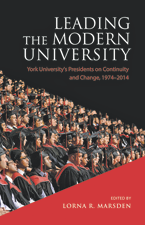
Lorna R. Marsden (ed).
University of Toronto Press, 2016; 248 pp;
SBN: 978-1-44264-875-3.
By Penni Stewart
Funding models and formulas, governance, academic planning, organizational restructuring and capital expansion are the issues at the heart of Leading the Modern University that provides an insider’s view from a series of university presidents (H. Ian Macdonald, Harry Arthurs, Susan Mann, Lorna Marsden and Mamdouh Shoukri), rather than a history of York.
Each of the five successive presidents provides a wealth of information about the challenges they faced, how crises were resolved, challenges overcome and everything made better, giving the volume a relentlessly celebratory tone. Definitely, there are things to be proud of. From a rocky start in 1959 as a small liberal arts university, York was one of several “new” universities established in a decade-long expansion of post-secondary education in Ontario. Nationally, it was one of a crop of second big-city universities competing with an elite, established institution. York is now the third largest university in Canada.
For each president, no challenge was more constant and pernicious than underfunding, which saw tuition climb from around a quarter to half of their budgets. Humanities and social sciences dominated within a provincial context of funding formulas that favoured science, medicine and engineering. York’s disadvantage was not only due to its disciplinary balance, however. In his chapter, titled “The economy is the secret police of our desires,” Harry Arthurs describes this dilemma vividly. In the mid-1980s he reports that York was receiving “only 79 cents for each dollar in operating grants provided to the average Ontario University … and had less than 2/3 of the academic space it was entitled to under the provincial formula.”
In the more than 40 years covered in this volume, York transformed itself many times over, including the development of academic planning and capital expansion. Marsden’s presidency saw the expansion of regional transportation linking York with suburbs to the north and west and a long-coveted agreement to extend the subway from downtown to York. Under current president Shoukri, the expansion of science and a new engineering faculty moved York closer to the goal of becoming a comprehensive university.
As York grew, it was transforming itself into a modern neo-liberal institution, in response to underfunding and to government demands for accountability, global partnerships and research tied to industry and business needs, and internationalization. Declining operating budgets led to increasing competition for tuition dollars. President Mann muses, “During these years universities began to lose their perception as communities of scholars and to become instead a collection of competitive entities.” Increasingly, the presidents were top managers of a large corporation whose administration accounted for a larger chunk of the budget. President Marsden’s mandate from the board of governors called for her to spend up to half of her time on external relations. “Internationalization” has been a preoccupation of president Shoukri.
Always fraught, the university’s shared governance has tilted towards the administration and away from the collegium. Under president Marsden, faculties were restructured, the senate was reorganized into a much smaller and more centralized body, and presidential searches became closed affairs.
Notably absent from this book is critical reflection on the changing role of the president and the state of post-secondary education, including the growth of sponsored research, the restructuring and cutbacks in the base funding of granting councils and the growth of targeted research funds through programs like the Canada Research Chairs. Only passing attention is paid to the underfunding-related creation of an enormous contingent labour force of once hopeful researchers and teachers, who have given up their dreams for pay-as-you-go careers. Nor do they consider the “overproduction” of what fuels the engine of casual labour or the concurrent rise of tuition fees and student debt. They share few details about the increasingly corporatized board of governors and the nature of presidential accountability to the board.
Since York’s establishment in the 1950s, the job of York president has been no picnic. This book shows the constant, difficult and often artful maneuvering of presidents to secure its place, even as the university world changed around them.
_______________________________________________
Penni Stewart is an associate professor in the department of sociology at York University.